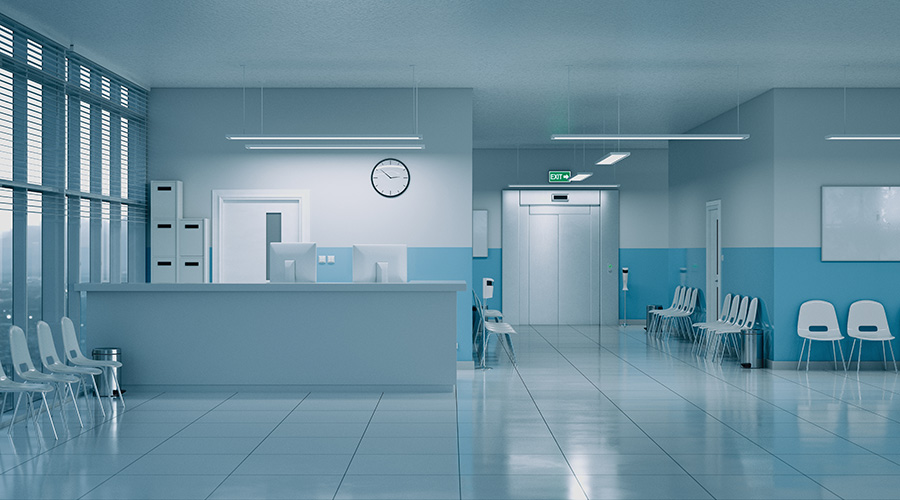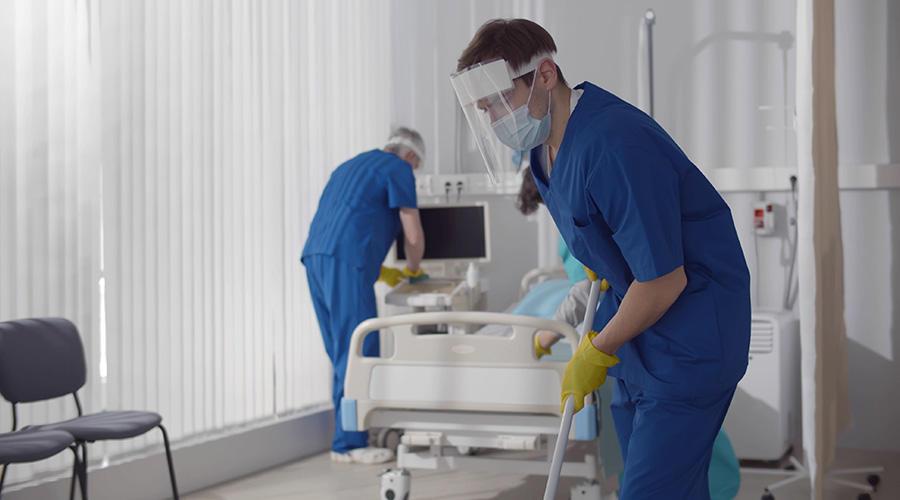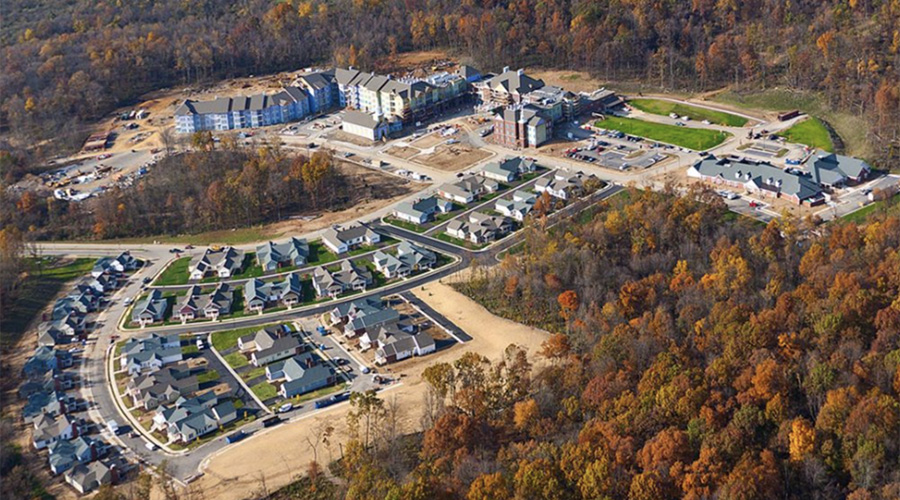Bryan Health is a locally owned, nonprofit healthcare organization serving patients in Nebraska, as well as parts of Kansas, Iowa, South Dakota and other states in the region. When a scheduled remodel neared, Bryan Health saw an opportunity to upgrade lighting throughout its East and West Campus locations in Nebraska and replace all their fluorescent luminaires with energy-efficient LEDs. A new, modern lighting system held the promise of significantly reducing energy consumption, lowering operating costs, and streamlining maintenance. But what else could it do? It turns out, quite a lot.
Mike Wiruth, master electrician at Bryan Health, explored lighting applications and integration strategies with internal stakeholders that could also support physician productivity and contribute to patient wellness and healing.
Project Goals:
- PERSONALIZATION. Give office personnel and medical health providers ability to set their own task lighting scenes. Lighting control is particularly important for radiologists when taking x-rays and reviewing scans.
- DIMMABILITY. Lighting fixtures needed to be dimmable to benefit from daylight harvesting but also to reduce brightness of the LED lights to reduce glare.
- EFFICIENCY. They needed a lighting system that could streamline and automate certain tasks, reduce unnecessary energy consumption and lower utility bills. As an added bonus, their utility, Lincoln Electric System, offered Bryan Health a rebate for each fluorescent lamp removed and a separate rebate to cover a percentage of labor costs for installing new controls.
- CENTRALIZATION. They also wanted to manage it all from an easy-to-use, cloud-based, centralized lighting system with advanced data visualization.
After reviewing lighting management options, Wiruth and his team selected Osram’s Encelium, a lighting management system with advanced lighting controls, an intuitive dashboard and intelligent data visualization. They strategically placed energy control units throughout the buildings, allowing Wiruth and his team to control all the lights remotely and get a bird’s-eye view of performance, use, and occupancy across both campus locations in real time.
In administrative office spaces, occupancy sensors were installed in each cubicle to automatically shut off the lights when the cubicle is unoccupied. Wiruth says this has been their highest energy saver.
In x-ray rooms, task tuning levels and preset lighting scenes were configured so radiologists could automatically set the most adequate light levels for viewing x-rays. Previously, nurses would manually dim the lights. Now, a Sensory Interface Module linked to a foot pedal automatically triggers a physician’s saved lighting preferences and custom scenes when the system is in X-Ray mode. When a physician removes their foot from the pedal, X-Ray mode is turned off and the system reverts to the original scene.
In the nurse’s station, a simple remote-control switch connected to the Encelium system was installed to allow nurses to open the ambulance bay door without leaving their station.
In large conference rooms, multiple lighting scenes are pre-programmed into an Encelium controller that is located “behind the scenes” in a storage room. When the room is booked, the scheduler identifies the appropriate lighting scene depending on whether the entire room is being used or if it’s being split into smaller conference rooms. This streamlines operations while saving energy.
In the Emergency Department, staff can now control the light in the heliport from six floors below using a networked switch. Previously, they turned the lights on using a three-way conduit that went from the second floor to the eighth-floor heliport. During a remodel, they would have been required to move the long conduit and opted to install the remote solution instead.
Investing in their lighting system resulted in significant energy and non-energy benefits. For example:
- ENERGY EFFICIENCY. The upgrades to LED along with thoughtful programming across the campus have yielded a 57 percent reduction in lighting energy use.
- BETTER DIAGNOSTICS. Preset lighting scenes in x-ray rooms facilitated highly accurate medical diagnosis for physicians and greatly simplified their workflow when reviewing x-rays. “Our radiologists and attending physicians have seen an extreme improvement in the quality of lighting and the user interface,” says Wiruth.
- FEWER SUPPORT CALLS. No longer needing to replace burned out fluorescent lamps, the number of support calls to the helpdesk and to the facility manager noticeably dropped.
- SHORTER RESPONSE TIMES. Now that facilities personnel can drill down and detect malfunctioning lights before users even notice, they can be more proactive in addressing general day-to-day lighting issues.
- INCREASED INDIVIDUAL COMFORT. Empowered to set, adjust, and customize their own lights to meet their individual needs, office staff and medical personnel expressed increased workplace satisfaction and comfort. “They can set their own light levels in their workspace to suit their needs on any given day,” says Wiruth.
- REMOTE CONTROL. Did someone forget to turn off the lights? No problem. With the system’s advanced lighting controls, Wiruth can switch a light on or off at any campus location. “As long as the lights are on our network, we can control them. It is fantastic and very reliable,” says Wiruth.
According to Wiruth, the lighting and controls system upgrade, implementation and integration process went smoothly. He shares the following advice for facility managers hoping to take on a similar integration project:
- START SMALL AND SCALE. Wiruth recommends not biting off more than you can chew. Procure and implement a system that can be easily scaled as your building portfolio grows or needs change.
- BECOME AN EXPERT. He recommends having someone on-site who takes ownership and is trained to understand the system inside and out. This saves time when the system requires modification or troubleshooting. Wiruth and another technician went to a day-long user training hosted by Osram. He read the user manual to familiarize himself with the lighting system and all its features. Additionally, he walks new contractors through the system whenever they come in for a remodeling project to minimize disruptions to operations.

 The OR HVAC Puzzle: Why Individual Systems Are on the Rise
The OR HVAC Puzzle: Why Individual Systems Are on the Rise Sutter Health Announces Plans for New Santa Clara Medical Center
Sutter Health Announces Plans for New Santa Clara Medical Center Sanford Health Receives $300M Gift for Black Hills Medical Center Campus
Sanford Health Receives $300M Gift for Black Hills Medical Center Campus Wanted: Scientific Standard for Hospital Cleaning
Wanted: Scientific Standard for Hospital Cleaning NLCS Strengthens Safety and Compliance with Comprehensive Electrical Program
NLCS Strengthens Safety and Compliance with Comprehensive Electrical Program